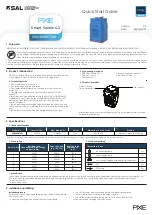
Technical Manual
Glass Push-button II Smart & Push-button Smart 86 [Series .02]
MDT technologies GmbH •
51766 Engelskirchen • Papiermühle 1 • Germany
Phone: +49-2263-
880 • [email protected] • www.mdt.de
89
89
4.5.2.1 Priority
The LED priority can force the status LED into a defined state and thus exceed the control via an
external / internal object or the button operation.
The following figure shows the available settings for each of the active LEDs:
Figure 46: Settings
–
LED Priority
The following table shows all available settings:
ETS-Text
Dynamic range
[Default value]
Comment
Object for priority
▪
not active
▪
active if object LED priority
value = 1
▪
active if object LED priority
value = 0
Sets the polarity of the LED priority.
LED display behaviour
for “Day”
any colour
[red]
Colour for an active LED priority in
Day mode.
Behaviour for “Day”
(value ON)
▪
permanent
▪
flashing
Setting of the lighting behaviour with
active LED priority in Day mode.
for “Night”
any colour
[red]
Colour for an active LED priority in
Night mode.
Behaviour for “Night”
(value ON)
▪
permanent
▪
flashing
Setting of the lighting behaviour with
active LED priority in Night mode.
Table 72: Settings
–
LED Priority
As long as the LED priority is active, the parameterized state for the LED priority is kept and the LED
does not react to the "normal" control as described in chapter
The following table shows the available communication objects:
Number
Name/Object Function
Length
Usage
117
LED 1 Priority
–
Switch
1 Bit
Controlling the LED priority
Table 73: Communication object
–
LED Priority











































